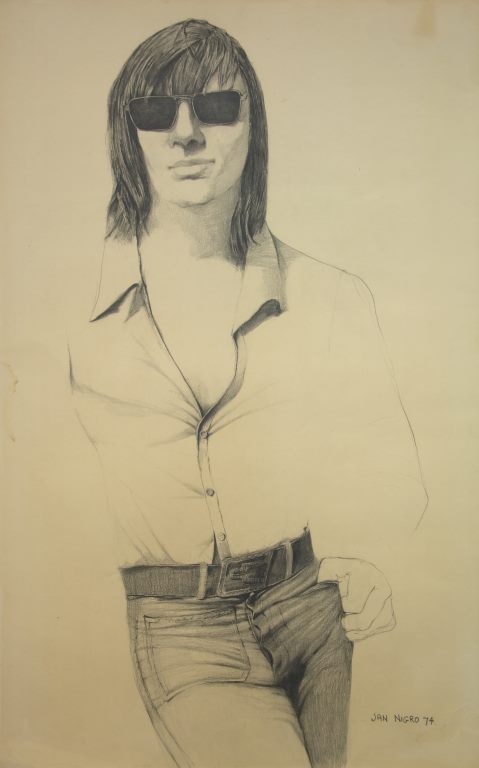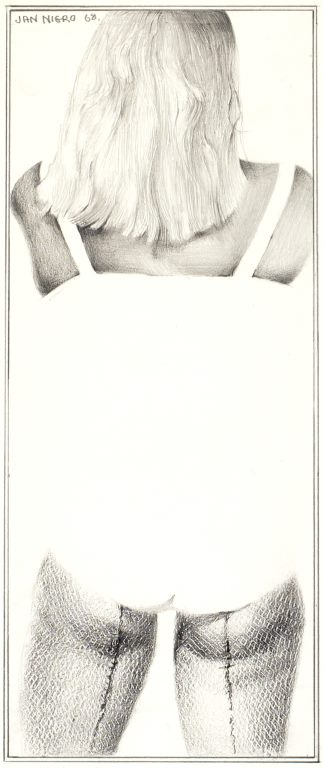Friday 30 March 2012
Ron Brownson

It is with wrenching sadness that I write of the recent passing of Jan Nigro. Born at Gisborne in 1920, Jan enrolled at the Elam School of Fine Arts in 1937. Her teachers were Auckland’s key art tutors of the period – Archibald Fisher, John Weeks and A. Lois White. Their inspiration and their commitment to figuration stayed with Jan for life. In fact, when I review New Zealand’s art scene she is one of the very few artists to have had a career of 75 years. We laughed about this remarkable fact – the length of her commitment to the visual arts – on almost every occasion that we met.
I much admired Jan. She asked me three times to speak at openings of her shows. Reviewing what I said on those occasions has only confirmed the deep conviction I have about her work. Here is an extract from the speech that I gave at Jan’s opening at Jane Sanders’s Gallery in March 2003. The Mayor of Auckland was present, as were two local Members of Parliament. It was a very big crowd. The show celebrated Bathers and there was much nudity and partial nudity. Some people were obviously surprised; some were trying hard not to seem startled. Jan did not set out to produce work that shocked but she did want the viewer to confront the nude reality of humanity.
I spoke loudly as it was a huge space: ‘One of the talents that I cherish about Jan Nigro is that she can really draw. In conversation with me she noted: “The figure was drummed into me by Archie Fisher, he dragged me into the life class, he trained me to look at the figure…I have had many years being frustrated in the lack of interest in the figurative.”
‘Jan’s right – we all know that figures can sometimes be scary in art, especially when they reach out to us and jolt us with what it means to look closely at the body. We have at least two ways to look at the figure. We know that there is a male gaze and a female gaze and that they are not the same way of seeing. To look at the body is to be its spectator.
‘Jan noted to me: “Naked and nude: there is no difference between the naked and the nude, but the public thinks so. Clothes give people a period in time but when you strip them, the body is quite universal…I have looked at women and men a lot. I look at male models and female models. Men and women are both people. I find men and women just as important as the other, as painterly models. I want to see from a male and from a female perspective… I look for the feminine shape in the female and the masculine shape in the male.”
‘If I were to use one adjective to describe Jan’s gaze, it would be this: scopophilic. This is the love of looking, of looking with love’s eye and with its heart. Jan does not objectify men and women into mere objects simply to be looked at. She does not make her figures wait for our eye; she makes them talk to our eye. She wants us to feel, like her, a desire to look. Looking is empowering because it accepts a human need that is rarely recognised for its own public essentiality. An eroticism where gender and sexuality come together as figural representation. I am not talking here about the voyeuristic or the festishistic. I am focusing on the nature of the gaze that Jan Nigro reveals: she invites us to question who is looking at whom, where and for why.’
In 2004, I spoke on the occasion of Jan Nigro’s exhibition Sad movies make me cry. I discovered the following statements while searching Google for references to Jan. To quote: ‘Jan Nigro is one of only a small number of successful New Zealand artists concentrating on the figure.’ ‘Jan is preoccupied with people, and thinks this is one reason why her work was initially accepted more readily in Australia than in New Zealand.’ ‘Jan Nigro’s figurative drawings are legendary for their blatant erotic realism.’
In 2010, I again spoke about Jan and I asked her, ‘How frank should I be Jan?’ She said ‘Be frank, utterly, be utterly frank.’ I realised just how difficult it had been for Jan to be a figurative artist who was known for addressing the nude with searing regard. The older she got, the braver she seemed. Here is what Jan said about this: ‘The nude has always been a no no to the general public. I need to look beyond the skin at the social, sexual, cultural or even psychological complexities although I admit that’s a tough one. Gender overlapping, looking for a different mood in male and female iconography, ambiguity: these are words I like.’
I said at the time, ‘I admire Jan for her staunch commitment. I respect her example, her bravery and her talent to never flinch away from the human figure but to celebrate it, to cherish it, to grapple with it, while never underplaying the true difficulty of dealing with gender and sexuality in New Zealand’s culture, let alone in New Zealand’s art culture.’

In 2009, Jan Nigro presented two exceptional artworks to the people of Auckland. I selected the two pieces and she generously presented them to Auckland Art Gallery Toi o Tāmaki. Summer Encounter dates from 1972–3. It is a close-up of a woman’s face, from just above her chin to the bridge of her nose. She wears large sunglasses and part of her face, from her left nostril, is occluded behind a vertical form which could be a curtain or it could be simply a vertical form. The painting plays with a conversation between abstraction and figuration, and this dialectic between representation and evocation has been a continuous conversation in Jan’s work.

The other gift was a large exhibition drawing entitled A Man of the Seventies. Jan drew this work in 1974. I showed a print of it to a colleague and I asked him what immediately came to mind and his reply was ‘Pop star – Mr Lee Grant’. Cocky, confident, sexy, sinuous, a girly sort of mannishness. If you were to do a survey of all the other drawings made in New Zealand during 1974 and you then you added in all the paintings made in New Zealand during 1974. You would not find any artwork that was in any way as sexualised as this one is.
Jan always caught her figure’s pose, their gesture, their clothing or lack of it, their contraposto, their sexiness. Jan made males less obviously masculine and more overtly feminine. It is one of her many gifts – to render gender and sexuality as what it is - a fluid, mobile, motile humanity.

Captions:
Jan Nigro
The Red Hat 1949
oil on board
purchased 1951
A Man of the Seventies 1974
pencil
gift of Jan Nigro, 2009
Summer Encounter 1972-73
oil on board
gift of Jan Nigro, 2009
Standing Woman 1968
pencil
purchased 1969
Auckland Art Gallery Toi o Tamaki